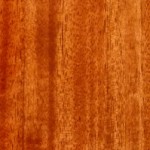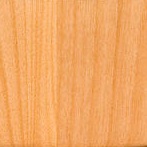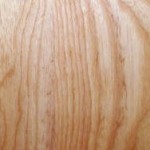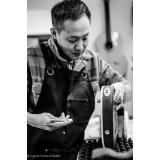What are your first thoughts when hearing a mind-blowing guitar? For me, I used to gravitate towards the pickups, or the manufacturer. But after working on many guitars and building a few, I started to gain a respect for the relationship between wood and tone. The way a particular tone wood shapes the overall tone of a guitar can often times get overlooked. When deciding on your perfect guitar, you ought to consider every factor.
At Halo Custom Guitars, we realize the importance of not only building you a quality guitar, but also the importance of informing you on every aspect of your custom guitar build. We want to provide you with the essential information required to achieve the ultimate tone you’re after. You design it, we build it.
Body Woods Offered at Halo Custom Guitars

Mahogany
Mahogany is well known around the guitar industry. It’s one of the most commonly used body woods in electric guitars and is, perhaps, most notably used by Gibson® on many of their Les Paul® and SG® models. Mahogany is characterized as having strong mids, balanced lows and a warm tone. Its provides a nice, thick tone that cuts through well in a mix, making it a popular choice among rock players. It is visually pleasing with practically any type of finish - natural, transparent colors, and bursts.

Alder
Alder is favored by blues and rock players for its strong and distinguished full-bodied sound. Its soft, tight pores help produce beefy mids and excellent lows... making this a go-to tone wood for both builders and players alike. Alder is light to medium in weight. It is tan with a hint of red in color, which makes it visually ideal for solid colors or sunbursts. Alder is often associated with the tone of a Fender®, as it is the main body wood used by Fender® since 1956.

Basswood
Basswood was popular around the 80’s and was favored among guitar virtuosos and shredders for its ability to produce smooth, creamy sounds without being overly sharp, or brittle. The light color and almost non-existent grain pattern makes Basswood great for solid colors, or as the core body wood paired with a figured top, like flamed maple or quilted maple. It is relatively soft yet stiff, lightweight, and stable, making it popular among various builders in the industry. Overall, basswood is growly with a warm tone and nice mids.

Ash
There are two commonly used types of Ash: Southern ("Swamp") Ash and Northern Ash. Swamp Ash comes from the Southern United States and Gulf Coast area. Swamp Ash grows partially under water, and that ultimately lightens the wood (in terms of weight) and adds stiffness. Swamp Ash is highly resonant with a mid-range roar. Northern Ash, on the other hand, is very heavy, hard and dense, which creates good sustain and bright tones. Both are great when paired with a transparent finish because of its vivid grain pattern.
These are the main tone woods we offer for our solid body electric guitar at Halo. If you’re looking for something not listed above, we do offer other choices upon request. We will gladly answer any questions you have about the tone woods we offer - just comment below or send us an email!
Thanks for reading!
Your email address cannot be published. Required fields are marked*


Between Mahogany, Alder, Ash, Basswood and Black Limba, it's safe to say that the Basswood is the average lightest?
HALO ADMIN RESPONSE: Yes, that is safe to say! - Jeff, Halo